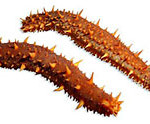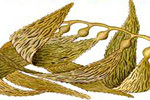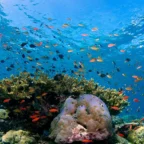
Hexagrammos decagrammus
The kelp greenling (Hexagrammos decagrammus) grows to a length of 60 cm. The mouth is small, terminal and directed upwards. The upper jaw reaches the anterior point below the eye orbit. The snout is blunt with thickened lips and the moderate teeth are in rows on the sides of the jaws and in patches at the tip. The head is conical and compressed. It has one notched dorsal fin, a rounded caudal (tail) fin and an anal fin with one dorsal spine. There is an erectable cirrus (slender tentacle) above and behind each eye and a small pair of cirri in between the eyes and dorsal fin.
Males are brown to olive with blue or copper; blue spots on the head and anterior portion of body. Each blue spot has a round ring of reddish spots. The dorsal and caudal fins are brown to black, the pelvic fins dusky blue and the pectoral fins spotted white. Females are light brown with orange to blue spots, their dorsal fins are red to orange with clouds of blue and the pectoral fins are pale yellow. Both sexes have an ocellus on the posterior end of the dorsal fin, an eye-shaped spot, usually dark-ringed, with a lighter colour inside, believed to deceive predators.
This indicator can be found at depths to 46 metres. It is principally benthic (bottom dwelling) but will swim to the surface in search of food. To be found in shallow waters with rocky and sandy substrates and common in kelp beds, the fish spawns in fall/winter with the male actively guarding the nest. It feeds on polychaetes (marine worms), mussels and small crustaceans and is distributed from southern California to the Aleutian Islands, although it is more common in northern waters.









Social Profiles